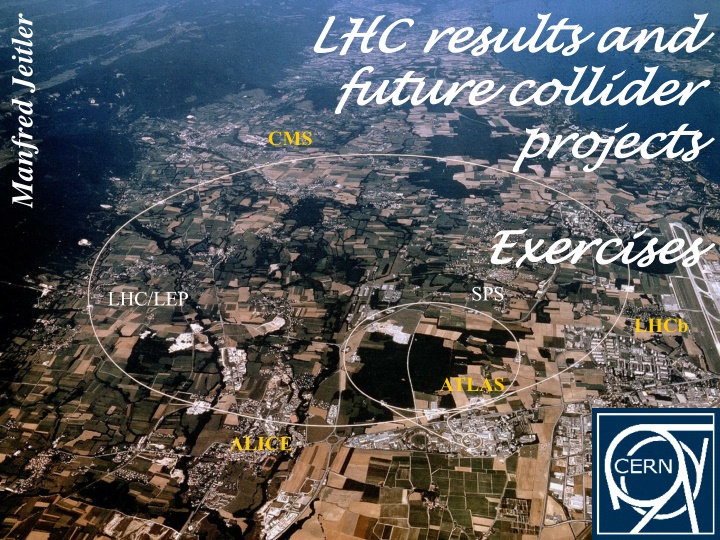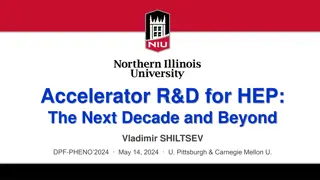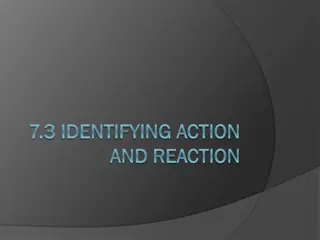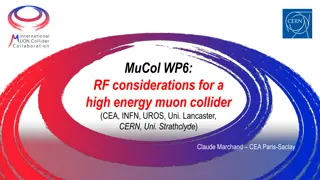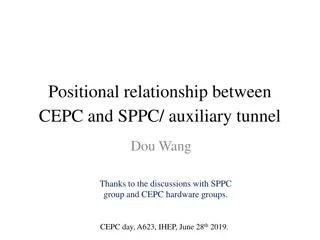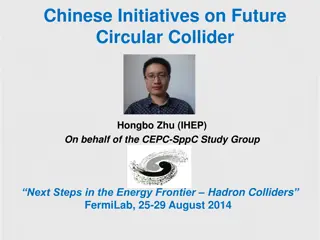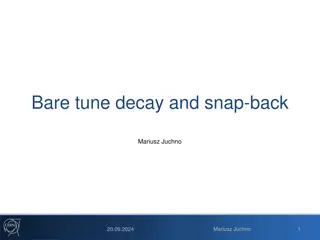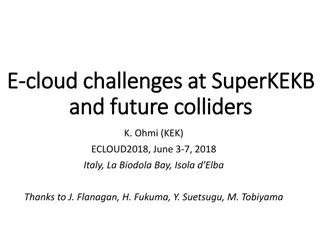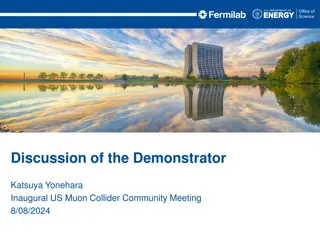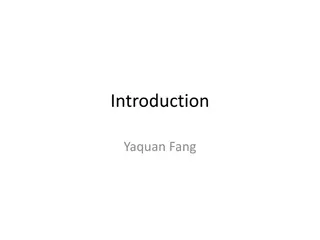Unraveling Collider Physics: Investigations, Interpretations, and Accelerations
Dive into the world of collider physics with a focus on LHC results, future collider projects, and experiments from the Baikal Summer School 2021. Explore topics like invariant mass calculations, Higgs boson decays, particle acceleration in the LHC tunnel, and particle velocity considerations. Engage in thought-provoking exercises and uncover the mysteries of particle physics in various collider experiments.
Download Presentation

Please find below an Image/Link to download the presentation.
The content on the website is provided AS IS for your information and personal use only. It may not be sold, licensed, or shared on other websites without obtaining consent from the author.If you encounter any issues during the download, it is possible that the publisher has removed the file from their server.
You are allowed to download the files provided on this website for personal or commercial use, subject to the condition that they are used lawfully. All files are the property of their respective owners.
The content on the website is provided AS IS for your information and personal use only. It may not be sold, licensed, or shared on other websites without obtaining consent from the author.
E N D
Presentation Transcript
LHC results and LHC results and future collider future collider projects projects Manfred Jeitler CMS Exercises Exercises SPS LHC/LEP LHCb ATLAS ALICE Manfred Jeitler 1 LHC & future colliders / exercises Baikal Summer School 2021
invariant mass in a collider experiment, you investigate events where nothing but two photons are detected: could such events be caused by the decay of Higgs bosons? try to draw the Feynman graph could they also be caused by other processes? by accident you find two events where in each of them one photon has an energy of 50 GeV while the other one has an energy of 156 GeV; however, in the first event the photons fly apart under a right angle (90 degrees) while in the other event they fly in opposite directions (180 degrees); which of the two events is more likely to be caused by the decay of a Higgs boson? hint: calculate the invariant mass of the two photons in both cases and compare them to the mass of the Higgs boson as measured by LHC (check at https://pdg.lbl.gov/ for the Higgs boson mass) if you are not familiar with the concept of invariant mass, check https://en.wikipedia.org/wiki/Invariant_mass if instead of the two photons you observed a + and a - with the same energies and angles, would your answer change? Manfred Jeitler LHC & future colliders / exercises Baikal Summer School 2021 2
particle acceleration The LHC tunnel is about 27 km long. Protons are injected into the LHC at an energy of 450 GeV. How much time do they need to travel once around the tunnel? If muons were injected at the same energy, would any of them survive the first turn (trip around the tunnel)? if yes: how many (percentage)? would any survive 1000 turns? how many? hint: check lifetime and mass of the muon at https://pdg.lbl.gov/ or at https://en.wikipedia.org/wiki/Muon At injection, the LHC s accelerating structures ( cavities ) switch field at (roughly) 40 MHz How far (how many meters) are the particle bunches from each other? hint: how long is the time between two 40-MHz periods and how far can the particles fly during one such period? Does the LHC frequency have to change during the acceleration of protons from 450 GeV to 6.5 TeV? Why? By how much? By how much does the velocity of the protons change during this? Does the field of the dipole magnets have to change at the same time? If yes, by how much (which factor)? Manfred Jeitler LHC & future colliders / exercises Baikal Summer School 2021 3
velocity of particles how fast do the protons in the LHC travel? at injection (450 GeV) after the end of the acceleration (6.5 TeV) how fast would electrons travel at the same energies? would this difference in velocity make any practical difference? hint: think about synchrotron radiation Manfred Jeitler LHC & future colliders / exercises Baikal Summer School 2021 4
colliders vs fixed-target experiments Colliding particles against other particles is much harder than hitting a fixed target with a particle beam. So, does it really make sense to build colliders? Which parameters of the beam are important in a collider? Which of them could be relaxed (less optimized) in a fixed-target accelerator? What would be the circumference of a fixed-target accelerator (with same dipole magnets as in the LHC) where a proton beam impinging on the protons in a target would produce the same center-of-mass energy as in an LHC collision (6.5 + 6.5 TeV)? hint: use four-vectors to calculate the energy (see next page) why not use much stronger dipole magnets? Manfred Jeitler LHC & future colliders / exercises Baikal Summer School 2021 5
Manfred Jeitler LHC & future colliders / exercises Baikal Summer School 2021 6
the power of the LHC beams a text in a CERN exhibition states: the force of the LHC beam is comparable to that of a herd of running elephants is this correct? hint: what could be meant by force ? momentum? kinetic energy? remember the energy and number of particles in LHC 6.5 TeV, 1011 protons per bunch, ~3000 bunches how heavy and fast is an elephant? which kind? Indian / African / Siberian? Manfred Jeitler LHC & future colliders / exercises Baikal Summer School 2021 7
the energy of one particle in the LHC another text says: the energy of a particle in LHC is the same as that of a flying mosquito is this correct? is there a contradiction to the statement about elephants? hint: how heavy and fast is a mosquito? Siberian mosquito compared to Indian elephant Manfred Jeitler LHC & future colliders / exercises Baikal Summer School 2021 8
COMMENTS Manfred Jeitler LHC & future colliders / exercises Baikal Summer School 2021 9
synchrotron radiation to lose less energy you may make particles heavier (4th power!) make accelerator bigger (only linear) electron synchrotron with same losses as LHC : LHC circumference: 27 km 27 * 20004 ~ 4 * 1014 km ~ 40 lightyears Manfred Jeitler LHC & future colliders / exercises Baikal Summer School 2021 10
